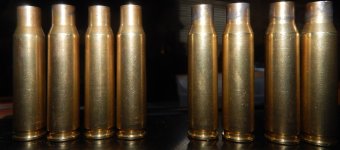Their are varying opinions on when to anneal. Not only how many reloads first, but before resizing or before seating. So I devised a test. I took 30 Lapua pieces of brass. I processed them all the same.
1. Deprime
2. Ultrasonic clean
3. Annealed
4. Lubed Lanolin and alcohol spray
5. Body size with Redding body die
6. Neck size
7. Trim
8. Tumble SS media
9. Inside neck chamfer
Then I separated 15 cases out and loaded them. The other 15 I annealed again. Then I loaded them. Exact same loads from then out. I did neck lube with a Q'tip with lanolin all 30 cases. The groups were very similar for both loads.
Series 7 Shots: 15
Min 2757 Max 2797
Avg 2786 S-D 10.6
ES 40
Series Shot Speed
7 1 2772 ft/s
7 2 2787 ft/s
7 3 2780 ft/s
7 4 2791 ft/s
7 5 2781 ft/s
7 6 2757 ft/s
7 7 2782 ft/s
7 8 2791 ft/s
7 9 2797 ft/s
7 10 2792 ft/s
7 11 2791 ft/s
7 12 2795 ft/s
7 13 2795 ft/s
7 14 2788 ft/s
7 15 2795 ft/s
---- ---- ---- ----
Series 8 Shots: 15
Min 2780 Max 2802
Avg 2790 S-D 6.30
ES 22
Series Shot Speed
8 1 2794 ft/s
8 2 2784 ft/s
8 3 2784 ft/s
8 4 2784 ft/s
8 5 2795 ft/s
8 6 2788 ft/s
8 7 2789 ft/s
8 8 2793 ft/s
8 9 2799 ft/s
8 10 2802 ft/s
8 11 2788 ft/s
8 12 2794 ft/s
8 13 2795 ft/s
8 14 2780 ft/s
8 15 2785 ft/s
---- ---- ---- ----
Everyone knows that sizing hardens the brass, what I didn't know is if annealing the brass twice would somehow ruin it. Well it appears from the spent shells are just fine. I'll take some measurements and see if their is any difference. The only change in appearance is they seemed to seal the chamber better. On the once annealed there are smudges part way down the neck that look like smoke. On the twice annealed brass it is a very clean neck. No sign of smudges. I know this is just a single test with only 15 shots each, but it is interesting. When seating the bullets the twice annealed brass was very very smooth seating. For once I got exactly what I expected (hoped) for. I know some will ask why not just do it once before you seat. I like how my brass resizes much better when it is freshly annealed.
Ok I measured the cases and all measure within .0005 of each other. No visible or measurable damage. What do you think?
1. Deprime
2. Ultrasonic clean
3. Annealed
4. Lubed Lanolin and alcohol spray
5. Body size with Redding body die
6. Neck size
7. Trim
8. Tumble SS media
9. Inside neck chamfer
Then I separated 15 cases out and loaded them. The other 15 I annealed again. Then I loaded them. Exact same loads from then out. I did neck lube with a Q'tip with lanolin all 30 cases. The groups were very similar for both loads.
Series 7 Shots: 15
Min 2757 Max 2797
Avg 2786 S-D 10.6
ES 40
Series Shot Speed
7 1 2772 ft/s
7 2 2787 ft/s
7 3 2780 ft/s
7 4 2791 ft/s
7 5 2781 ft/s
7 6 2757 ft/s
7 7 2782 ft/s
7 8 2791 ft/s
7 9 2797 ft/s
7 10 2792 ft/s
7 11 2791 ft/s
7 12 2795 ft/s
7 13 2795 ft/s
7 14 2788 ft/s
7 15 2795 ft/s
---- ---- ---- ----
Series 8 Shots: 15
Min 2780 Max 2802
Avg 2790 S-D 6.30
ES 22
Series Shot Speed
8 1 2794 ft/s
8 2 2784 ft/s
8 3 2784 ft/s
8 4 2784 ft/s
8 5 2795 ft/s
8 6 2788 ft/s
8 7 2789 ft/s
8 8 2793 ft/s
8 9 2799 ft/s
8 10 2802 ft/s
8 11 2788 ft/s
8 12 2794 ft/s
8 13 2795 ft/s
8 14 2780 ft/s
8 15 2785 ft/s
---- ---- ---- ----
Everyone knows that sizing hardens the brass, what I didn't know is if annealing the brass twice would somehow ruin it. Well it appears from the spent shells are just fine. I'll take some measurements and see if their is any difference. The only change in appearance is they seemed to seal the chamber better. On the once annealed there are smudges part way down the neck that look like smoke. On the twice annealed brass it is a very clean neck. No sign of smudges. I know this is just a single test with only 15 shots each, but it is interesting. When seating the bullets the twice annealed brass was very very smooth seating. For once I got exactly what I expected (hoped) for. I know some will ask why not just do it once before you seat. I like how my brass resizes much better when it is freshly annealed.
Ok I measured the cases and all measure within .0005 of each other. No visible or measurable damage. What do you think?


